Management Report: Self-Development Portfolio for Tesco Junior Manager
VerifiedAdded on 2022/10/02
|21
|4680
|94
Report
AI Summary
This report analyzes the role of a junior line manager at Tesco, detailing a self-development portfolio. It begins with a personal skills audit, SWOT analysis, and a development plan for the job role, emphasizing communication and leadership skills. The report then explores organizational and individual learning, differentiating between them and examining the Continuous Development Process (CDP). It covers training gap analysis, learning cycle models, and barriers to learning. Furthermore, the report delves into High-Performance Work (HPW), performance management, organizational culture, and the transformation process. The conclusion provides recommendations for improving leadership and management skills within Tesco. The assignment also includes a reflective statement and feedback for learning, demonstrating the student's understanding of the course material and ability to apply it to a real-world scenario. The report aims to provide a comprehensive overview of the junior line manager's responsibilities and development opportunities.
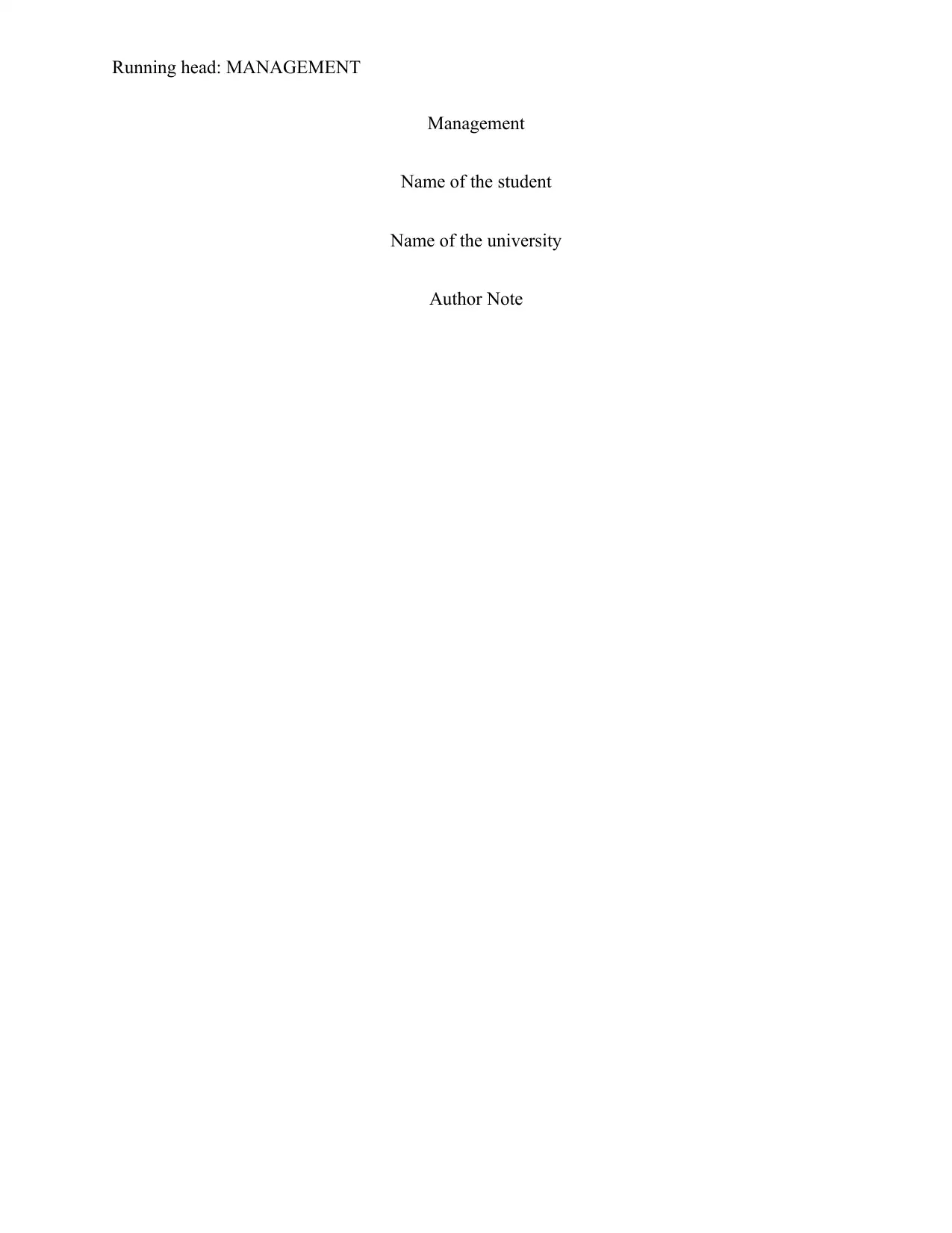
Running head: MANAGEMENT
Management
Name of the student
Name of the university
Author Note
Management
Name of the student
Name of the university
Author Note
Paraphrase This Document
Need a fresh take? Get an instant paraphrase of this document with our AI Paraphraser
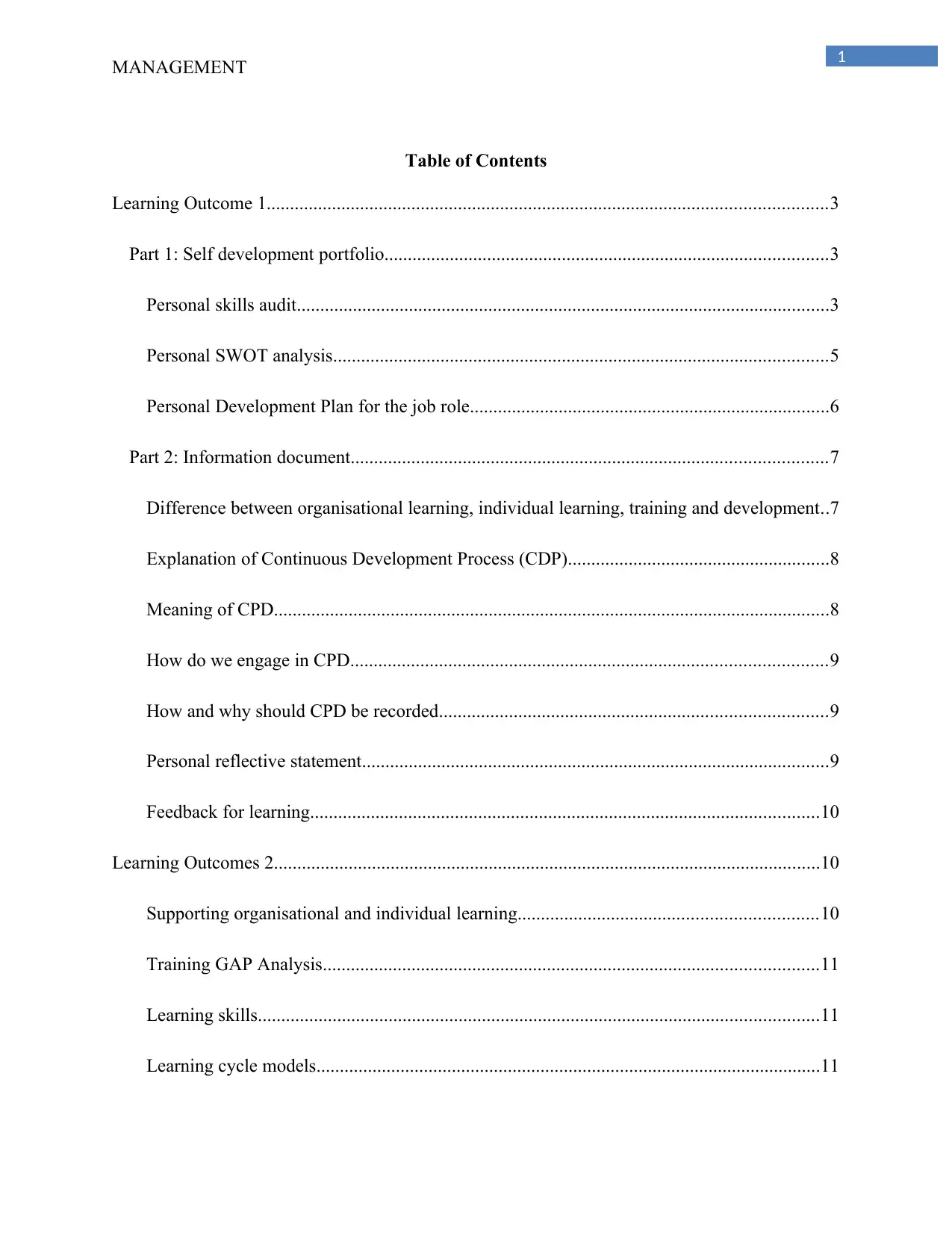
1
MANAGEMENT
Table of Contents
Learning Outcome 1........................................................................................................................3
Part 1: Self development portfolio...............................................................................................3
Personal skills audit..................................................................................................................3
Personal SWOT analysis..........................................................................................................5
Personal Development Plan for the job role.............................................................................6
Part 2: Information document......................................................................................................7
Difference between organisational learning, individual learning, training and development..7
Explanation of Continuous Development Process (CDP)........................................................8
Meaning of CPD.......................................................................................................................8
How do we engage in CPD......................................................................................................9
How and why should CPD be recorded...................................................................................9
Personal reflective statement....................................................................................................9
Feedback for learning.............................................................................................................10
Learning Outcomes 2.....................................................................................................................10
Supporting organisational and individual learning................................................................10
Training GAP Analysis..........................................................................................................11
Learning skills........................................................................................................................11
Learning cycle models............................................................................................................11
MANAGEMENT
Table of Contents
Learning Outcome 1........................................................................................................................3
Part 1: Self development portfolio...............................................................................................3
Personal skills audit..................................................................................................................3
Personal SWOT analysis..........................................................................................................5
Personal Development Plan for the job role.............................................................................6
Part 2: Information document......................................................................................................7
Difference between organisational learning, individual learning, training and development..7
Explanation of Continuous Development Process (CDP)........................................................8
Meaning of CPD.......................................................................................................................8
How do we engage in CPD......................................................................................................9
How and why should CPD be recorded...................................................................................9
Personal reflective statement....................................................................................................9
Feedback for learning.............................................................................................................10
Learning Outcomes 2.....................................................................................................................10
Supporting organisational and individual learning................................................................10
Training GAP Analysis..........................................................................................................11
Learning skills........................................................................................................................11
Learning cycle models............................................................................................................11
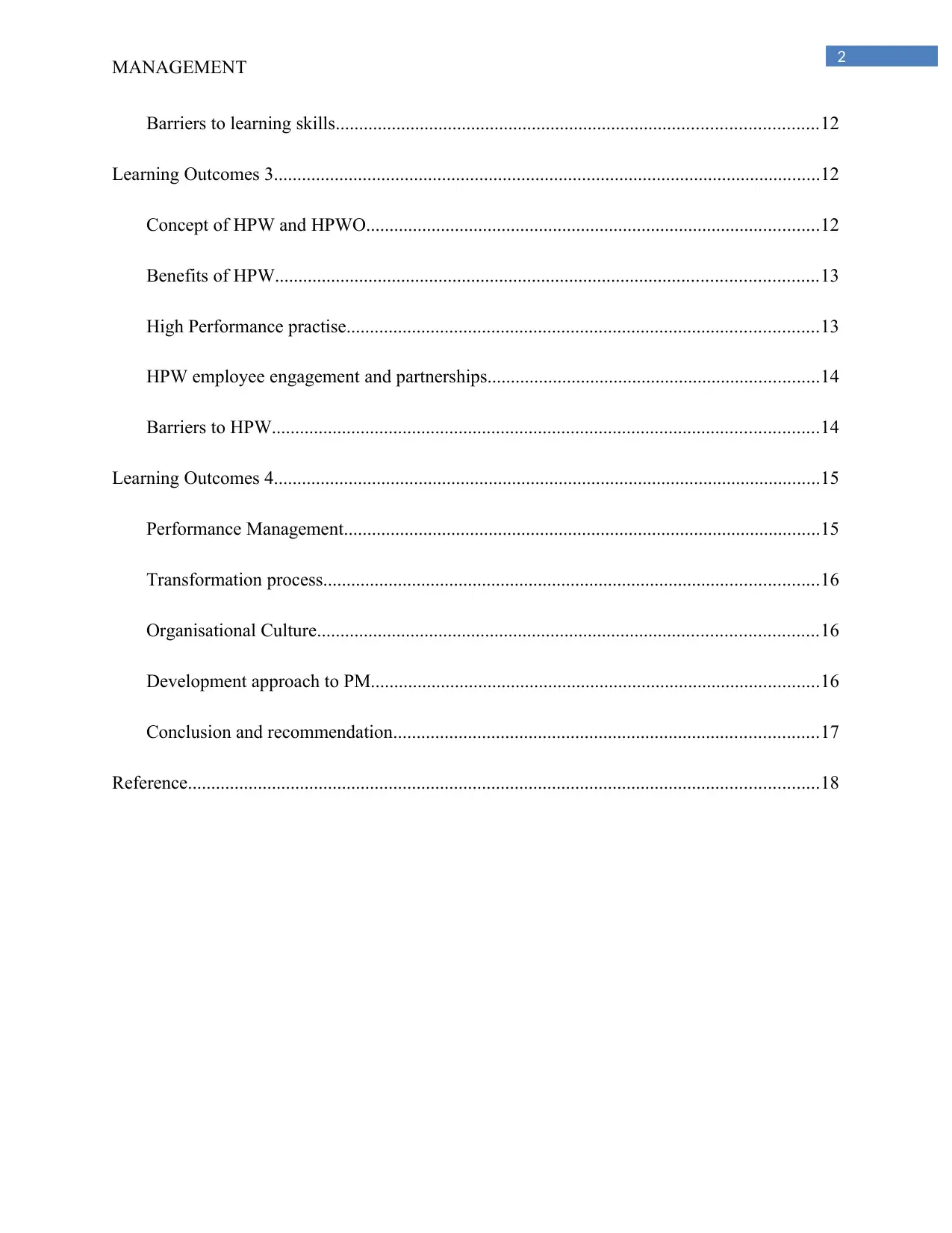
2
MANAGEMENT
Barriers to learning skills.......................................................................................................12
Learning Outcomes 3.....................................................................................................................12
Concept of HPW and HPWO.................................................................................................12
Benefits of HPW....................................................................................................................13
High Performance practise.....................................................................................................13
HPW employee engagement and partnerships.......................................................................14
Barriers to HPW.....................................................................................................................14
Learning Outcomes 4.....................................................................................................................15
Performance Management......................................................................................................15
Transformation process..........................................................................................................16
Organisational Culture...........................................................................................................16
Development approach to PM................................................................................................16
Conclusion and recommendation...........................................................................................17
Reference.......................................................................................................................................18
MANAGEMENT
Barriers to learning skills.......................................................................................................12
Learning Outcomes 3.....................................................................................................................12
Concept of HPW and HPWO.................................................................................................12
Benefits of HPW....................................................................................................................13
High Performance practise.....................................................................................................13
HPW employee engagement and partnerships.......................................................................14
Barriers to HPW.....................................................................................................................14
Learning Outcomes 4.....................................................................................................................15
Performance Management......................................................................................................15
Transformation process..........................................................................................................16
Organisational Culture...........................................................................................................16
Development approach to PM................................................................................................16
Conclusion and recommendation...........................................................................................17
Reference.......................................................................................................................................18
⊘ This is a preview!⊘
Do you want full access?
Subscribe today to unlock all pages.

Trusted by 1+ million students worldwide
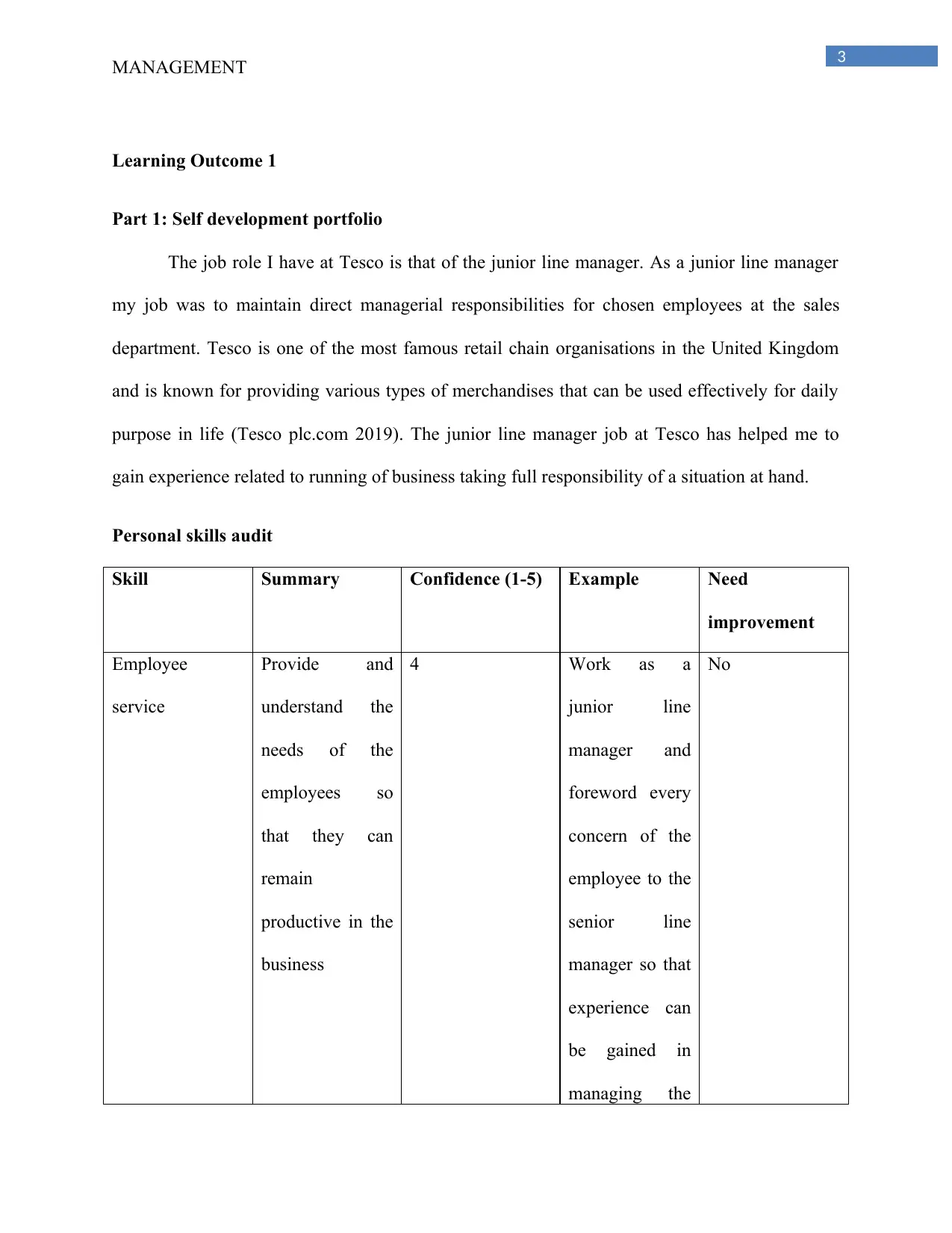
3
MANAGEMENT
Learning Outcome 1
Part 1: Self development portfolio
The job role I have at Tesco is that of the junior line manager. As a junior line manager
my job was to maintain direct managerial responsibilities for chosen employees at the sales
department. Tesco is one of the most famous retail chain organisations in the United Kingdom
and is known for providing various types of merchandises that can be used effectively for daily
purpose in life (Tesco plc.com 2019). The junior line manager job at Tesco has helped me to
gain experience related to running of business taking full responsibility of a situation at hand.
Personal skills audit
Skill Summary Confidence (1-5) Example Need
improvement
Employee
service
Provide and
understand the
needs of the
employees so
that they can
remain
productive in the
business
4 Work as a
junior line
manager and
foreword every
concern of the
employee to the
senior line
manager so that
experience can
be gained in
managing the
No
MANAGEMENT
Learning Outcome 1
Part 1: Self development portfolio
The job role I have at Tesco is that of the junior line manager. As a junior line manager
my job was to maintain direct managerial responsibilities for chosen employees at the sales
department. Tesco is one of the most famous retail chain organisations in the United Kingdom
and is known for providing various types of merchandises that can be used effectively for daily
purpose in life (Tesco plc.com 2019). The junior line manager job at Tesco has helped me to
gain experience related to running of business taking full responsibility of a situation at hand.
Personal skills audit
Skill Summary Confidence (1-5) Example Need
improvement
Employee
service
Provide and
understand the
needs of the
employees so
that they can
remain
productive in the
business
4 Work as a
junior line
manager and
foreword every
concern of the
employee to the
senior line
manager so that
experience can
be gained in
managing the
No
Paraphrase This Document
Need a fresh take? Get an instant paraphrase of this document with our AI Paraphraser
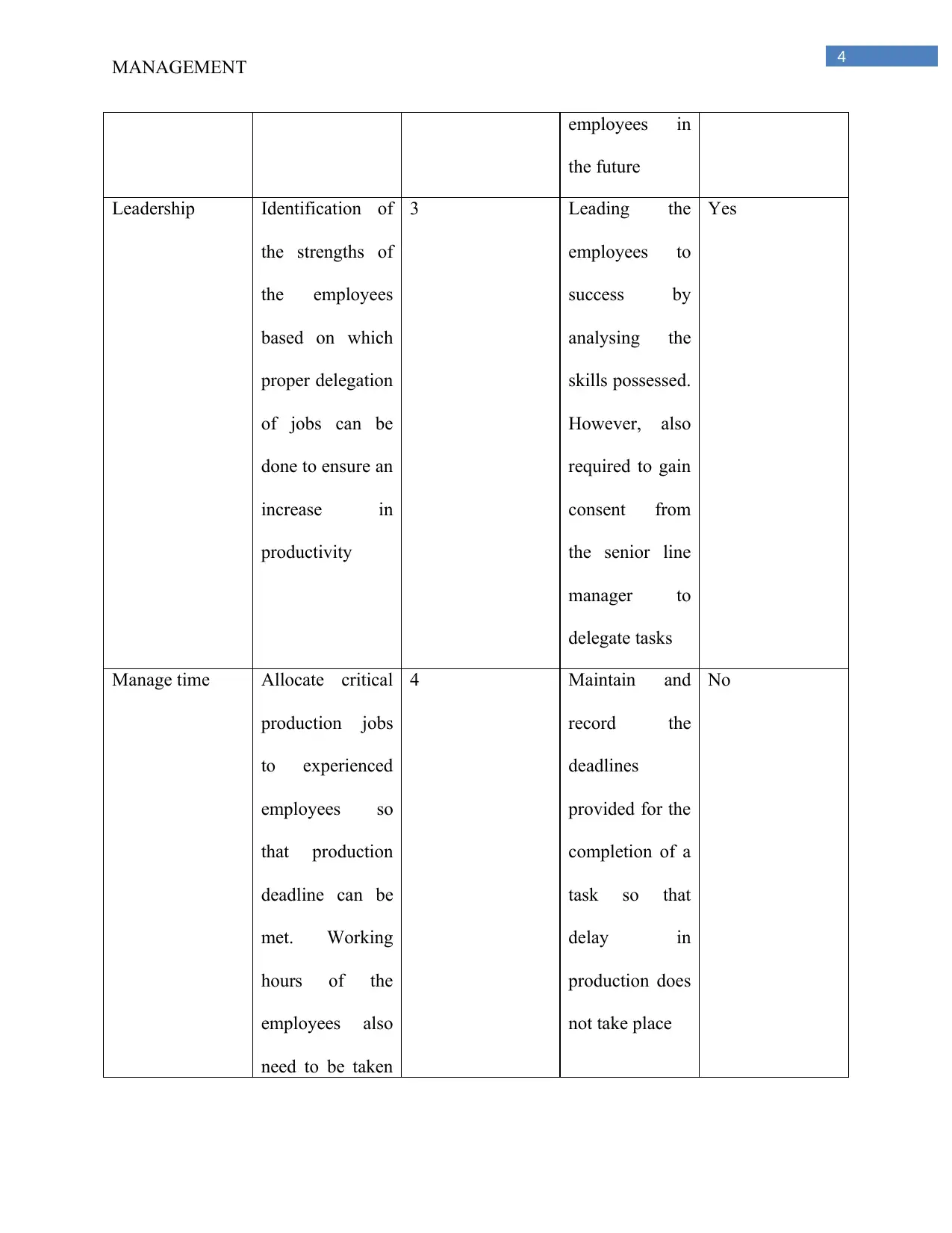
4
MANAGEMENT
employees in
the future
Leadership Identification of
the strengths of
the employees
based on which
proper delegation
of jobs can be
done to ensure an
increase in
productivity
3 Leading the
employees to
success by
analysing the
skills possessed.
However, also
required to gain
consent from
the senior line
manager to
delegate tasks
Yes
Manage time Allocate critical
production jobs
to experienced
employees so
that production
deadline can be
met. Working
hours of the
employees also
need to be taken
4 Maintain and
record the
deadlines
provided for the
completion of a
task so that
delay in
production does
not take place
No
MANAGEMENT
employees in
the future
Leadership Identification of
the strengths of
the employees
based on which
proper delegation
of jobs can be
done to ensure an
increase in
productivity
3 Leading the
employees to
success by
analysing the
skills possessed.
However, also
required to gain
consent from
the senior line
manager to
delegate tasks
Yes
Manage time Allocate critical
production jobs
to experienced
employees so
that production
deadline can be
met. Working
hours of the
employees also
need to be taken
4 Maintain and
record the
deadlines
provided for the
completion of a
task so that
delay in
production does
not take place
No
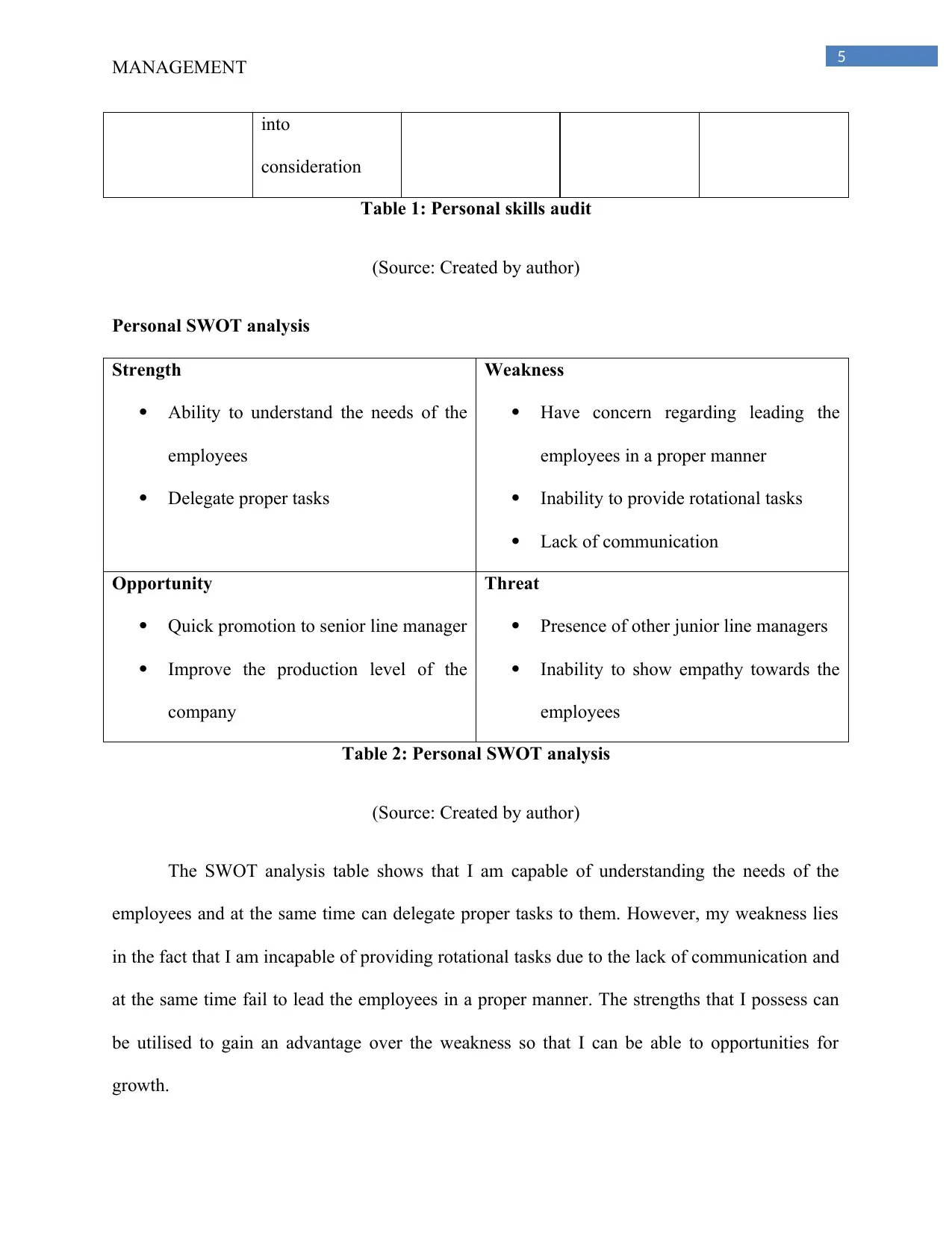
5
MANAGEMENT
into
consideration
Table 1: Personal skills audit
(Source: Created by author)
Personal SWOT analysis
Strength
Ability to understand the needs of the
employees
Delegate proper tasks
Weakness
Have concern regarding leading the
employees in a proper manner
Inability to provide rotational tasks
Lack of communication
Opportunity
Quick promotion to senior line manager
Improve the production level of the
company
Threat
Presence of other junior line managers
Inability to show empathy towards the
employees
Table 2: Personal SWOT analysis
(Source: Created by author)
The SWOT analysis table shows that I am capable of understanding the needs of the
employees and at the same time can delegate proper tasks to them. However, my weakness lies
in the fact that I am incapable of providing rotational tasks due to the lack of communication and
at the same time fail to lead the employees in a proper manner. The strengths that I possess can
be utilised to gain an advantage over the weakness so that I can be able to opportunities for
growth.
MANAGEMENT
into
consideration
Table 1: Personal skills audit
(Source: Created by author)
Personal SWOT analysis
Strength
Ability to understand the needs of the
employees
Delegate proper tasks
Weakness
Have concern regarding leading the
employees in a proper manner
Inability to provide rotational tasks
Lack of communication
Opportunity
Quick promotion to senior line manager
Improve the production level of the
company
Threat
Presence of other junior line managers
Inability to show empathy towards the
employees
Table 2: Personal SWOT analysis
(Source: Created by author)
The SWOT analysis table shows that I am capable of understanding the needs of the
employees and at the same time can delegate proper tasks to them. However, my weakness lies
in the fact that I am incapable of providing rotational tasks due to the lack of communication and
at the same time fail to lead the employees in a proper manner. The strengths that I possess can
be utilised to gain an advantage over the weakness so that I can be able to opportunities for
growth.
⊘ This is a preview!⊘
Do you want full access?
Subscribe today to unlock all pages.

Trusted by 1+ million students worldwide
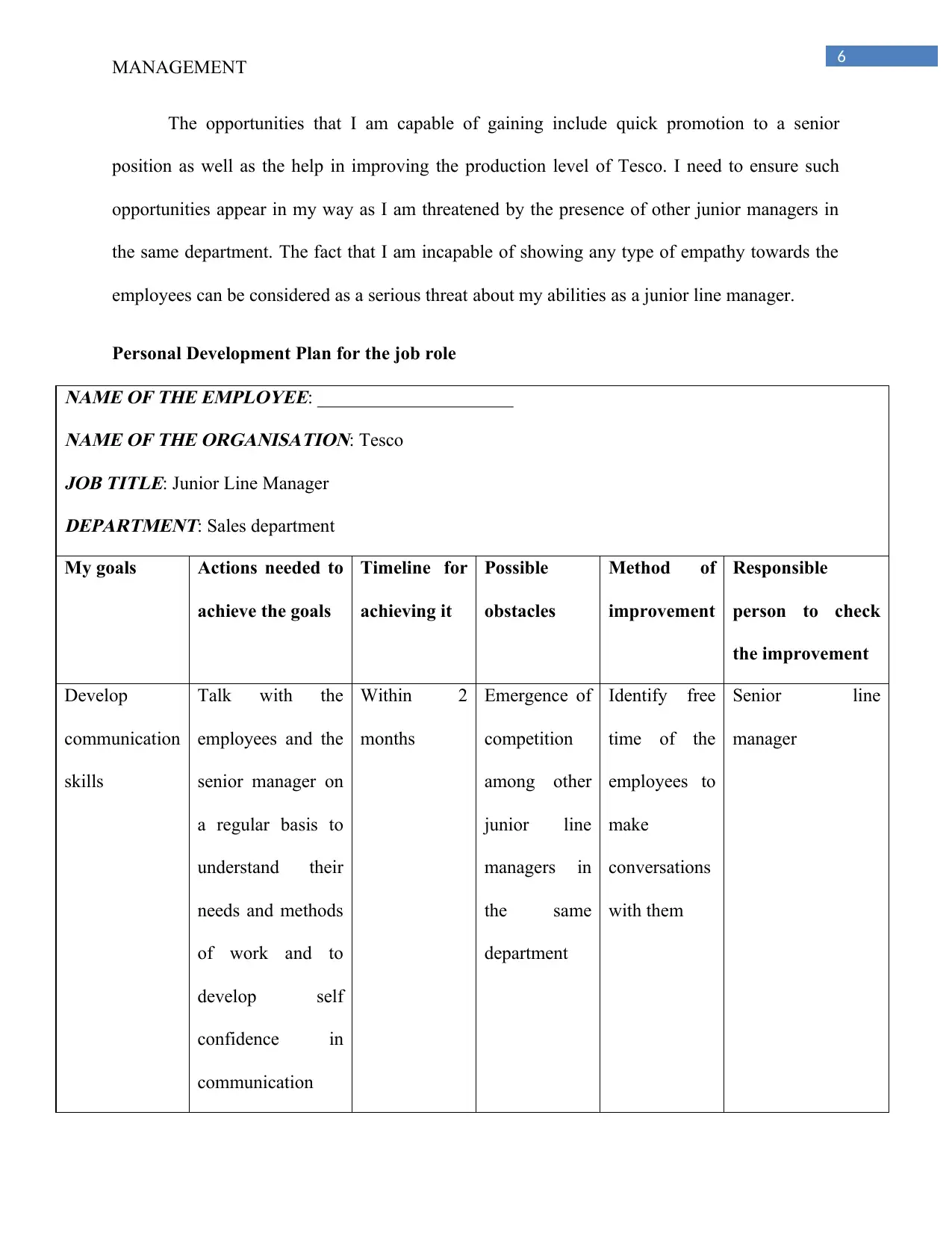
6
MANAGEMENT
The opportunities that I am capable of gaining include quick promotion to a senior
position as well as the help in improving the production level of Tesco. I need to ensure such
opportunities appear in my way as I am threatened by the presence of other junior managers in
the same department. The fact that I am incapable of showing any type of empathy towards the
employees can be considered as a serious threat about my abilities as a junior line manager.
Personal Development Plan for the job role
NAME OF THE EMPLOYEE: _____________________
NAME OF THE ORGANISATION: Tesco
JOB TITLE: Junior Line Manager
DEPARTMENT: Sales department
My goals Actions needed to
achieve the goals
Timeline for
achieving it
Possible
obstacles
Method of
improvement
Responsible
person to check
the improvement
Develop
communication
skills
Talk with the
employees and the
senior manager on
a regular basis to
understand their
needs and methods
of work and to
develop self
confidence in
communication
Within 2
months
Emergence of
competition
among other
junior line
managers in
the same
department
Identify free
time of the
employees to
make
conversations
with them
Senior line
manager
MANAGEMENT
The opportunities that I am capable of gaining include quick promotion to a senior
position as well as the help in improving the production level of Tesco. I need to ensure such
opportunities appear in my way as I am threatened by the presence of other junior managers in
the same department. The fact that I am incapable of showing any type of empathy towards the
employees can be considered as a serious threat about my abilities as a junior line manager.
Personal Development Plan for the job role
NAME OF THE EMPLOYEE: _____________________
NAME OF THE ORGANISATION: Tesco
JOB TITLE: Junior Line Manager
DEPARTMENT: Sales department
My goals Actions needed to
achieve the goals
Timeline for
achieving it
Possible
obstacles
Method of
improvement
Responsible
person to check
the improvement
Develop
communication
skills
Talk with the
employees and the
senior manager on
a regular basis to
understand their
needs and methods
of work and to
develop self
confidence in
communication
Within 2
months
Emergence of
competition
among other
junior line
managers in
the same
department
Identify free
time of the
employees to
make
conversations
with them
Senior line
manager
Paraphrase This Document
Need a fresh take? Get an instant paraphrase of this document with our AI Paraphraser
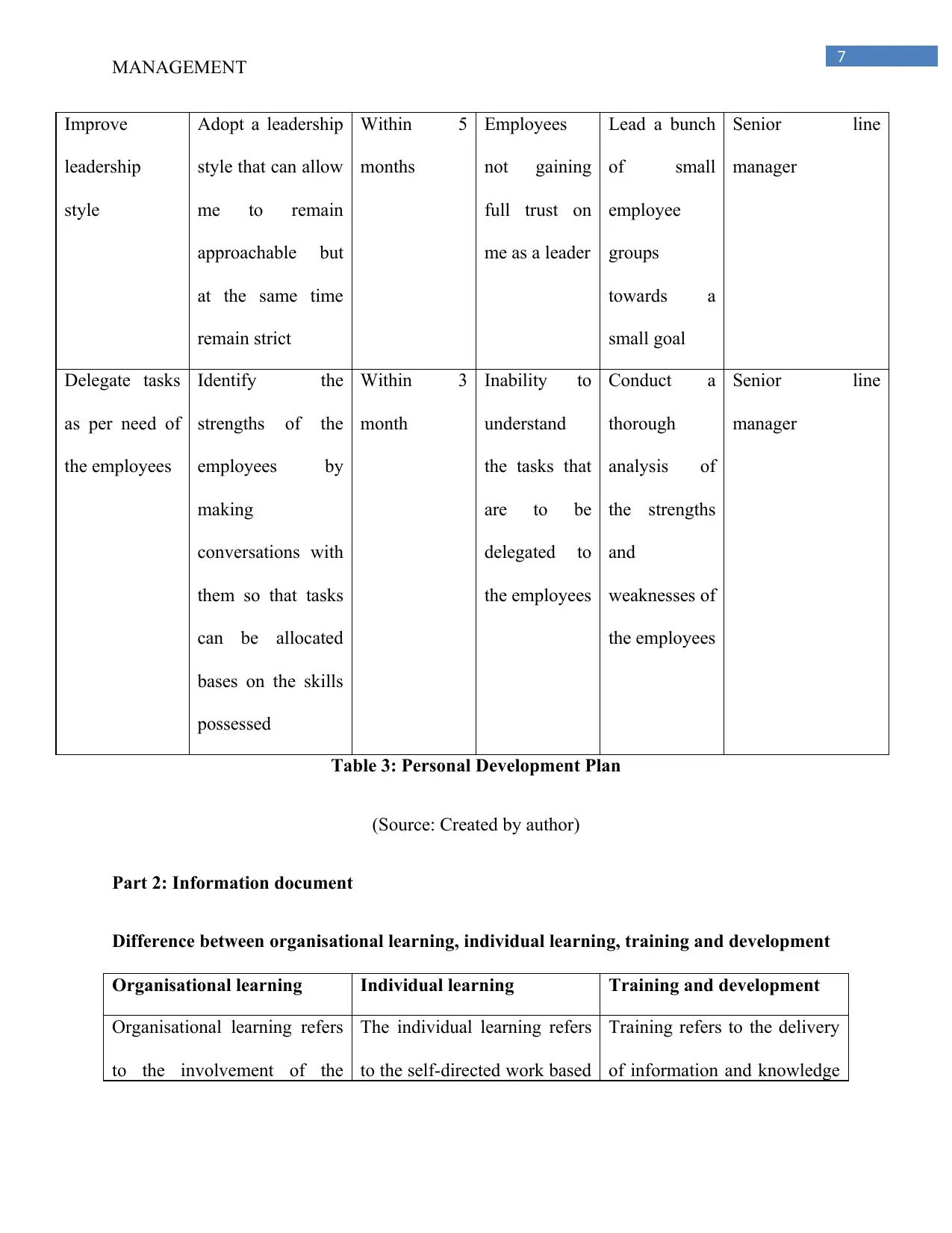
7
MANAGEMENT
Improve
leadership
style
Adopt a leadership
style that can allow
me to remain
approachable but
at the same time
remain strict
Within 5
months
Employees
not gaining
full trust on
me as a leader
Lead a bunch
of small
employee
groups
towards a
small goal
Senior line
manager
Delegate tasks
as per need of
the employees
Identify the
strengths of the
employees by
making
conversations with
them so that tasks
can be allocated
bases on the skills
possessed
Within 3
month
Inability to
understand
the tasks that
are to be
delegated to
the employees
Conduct a
thorough
analysis of
the strengths
and
weaknesses of
the employees
Senior line
manager
Table 3: Personal Development Plan
(Source: Created by author)
Part 2: Information document
Difference between organisational learning, individual learning, training and development
Organisational learning Individual learning Training and development
Organisational learning refers
to the involvement of the
The individual learning refers
to the self-directed work based
Training refers to the delivery
of information and knowledge
MANAGEMENT
Improve
leadership
style
Adopt a leadership
style that can allow
me to remain
approachable but
at the same time
remain strict
Within 5
months
Employees
not gaining
full trust on
me as a leader
Lead a bunch
of small
employee
groups
towards a
small goal
Senior line
manager
Delegate tasks
as per need of
the employees
Identify the
strengths of the
employees by
making
conversations with
them so that tasks
can be allocated
bases on the skills
possessed
Within 3
month
Inability to
understand
the tasks that
are to be
delegated to
the employees
Conduct a
thorough
analysis of
the strengths
and
weaknesses of
the employees
Senior line
manager
Table 3: Personal Development Plan
(Source: Created by author)
Part 2: Information document
Difference between organisational learning, individual learning, training and development
Organisational learning Individual learning Training and development
Organisational learning refers
to the involvement of the
The individual learning refers
to the self-directed work based
Training refers to the delivery
of information and knowledge
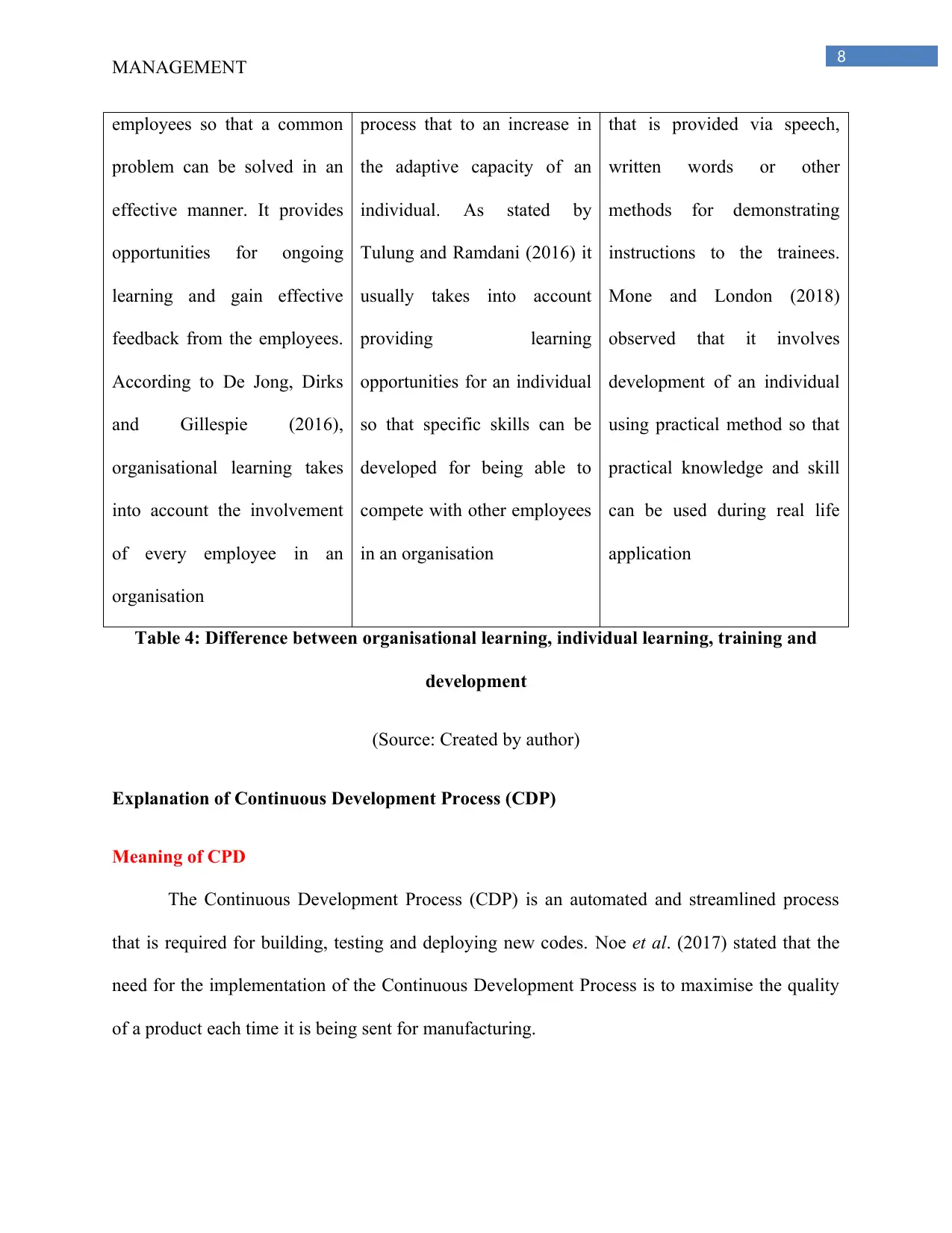
8
MANAGEMENT
employees so that a common
problem can be solved in an
effective manner. It provides
opportunities for ongoing
learning and gain effective
feedback from the employees.
According to De Jong, Dirks
and Gillespie (2016),
organisational learning takes
into account the involvement
of every employee in an
organisation
process that to an increase in
the adaptive capacity of an
individual. As stated by
Tulung and Ramdani (2016) it
usually takes into account
providing learning
opportunities for an individual
so that specific skills can be
developed for being able to
compete with other employees
in an organisation
that is provided via speech,
written words or other
methods for demonstrating
instructions to the trainees.
Mone and London (2018)
observed that it involves
development of an individual
using practical method so that
practical knowledge and skill
can be used during real life
application
Table 4: Difference between organisational learning, individual learning, training and
development
(Source: Created by author)
Explanation of Continuous Development Process (CDP)
Meaning of CPD
The Continuous Development Process (CDP) is an automated and streamlined process
that is required for building, testing and deploying new codes. Noe et al. (2017) stated that the
need for the implementation of the Continuous Development Process is to maximise the quality
of a product each time it is being sent for manufacturing.
MANAGEMENT
employees so that a common
problem can be solved in an
effective manner. It provides
opportunities for ongoing
learning and gain effective
feedback from the employees.
According to De Jong, Dirks
and Gillespie (2016),
organisational learning takes
into account the involvement
of every employee in an
organisation
process that to an increase in
the adaptive capacity of an
individual. As stated by
Tulung and Ramdani (2016) it
usually takes into account
providing learning
opportunities for an individual
so that specific skills can be
developed for being able to
compete with other employees
in an organisation
that is provided via speech,
written words or other
methods for demonstrating
instructions to the trainees.
Mone and London (2018)
observed that it involves
development of an individual
using practical method so that
practical knowledge and skill
can be used during real life
application
Table 4: Difference between organisational learning, individual learning, training and
development
(Source: Created by author)
Explanation of Continuous Development Process (CDP)
Meaning of CPD
The Continuous Development Process (CDP) is an automated and streamlined process
that is required for building, testing and deploying new codes. Noe et al. (2017) stated that the
need for the implementation of the Continuous Development Process is to maximise the quality
of a product each time it is being sent for manufacturing.
⊘ This is a preview!⊘
Do you want full access?
Subscribe today to unlock all pages.

Trusted by 1+ million students worldwide
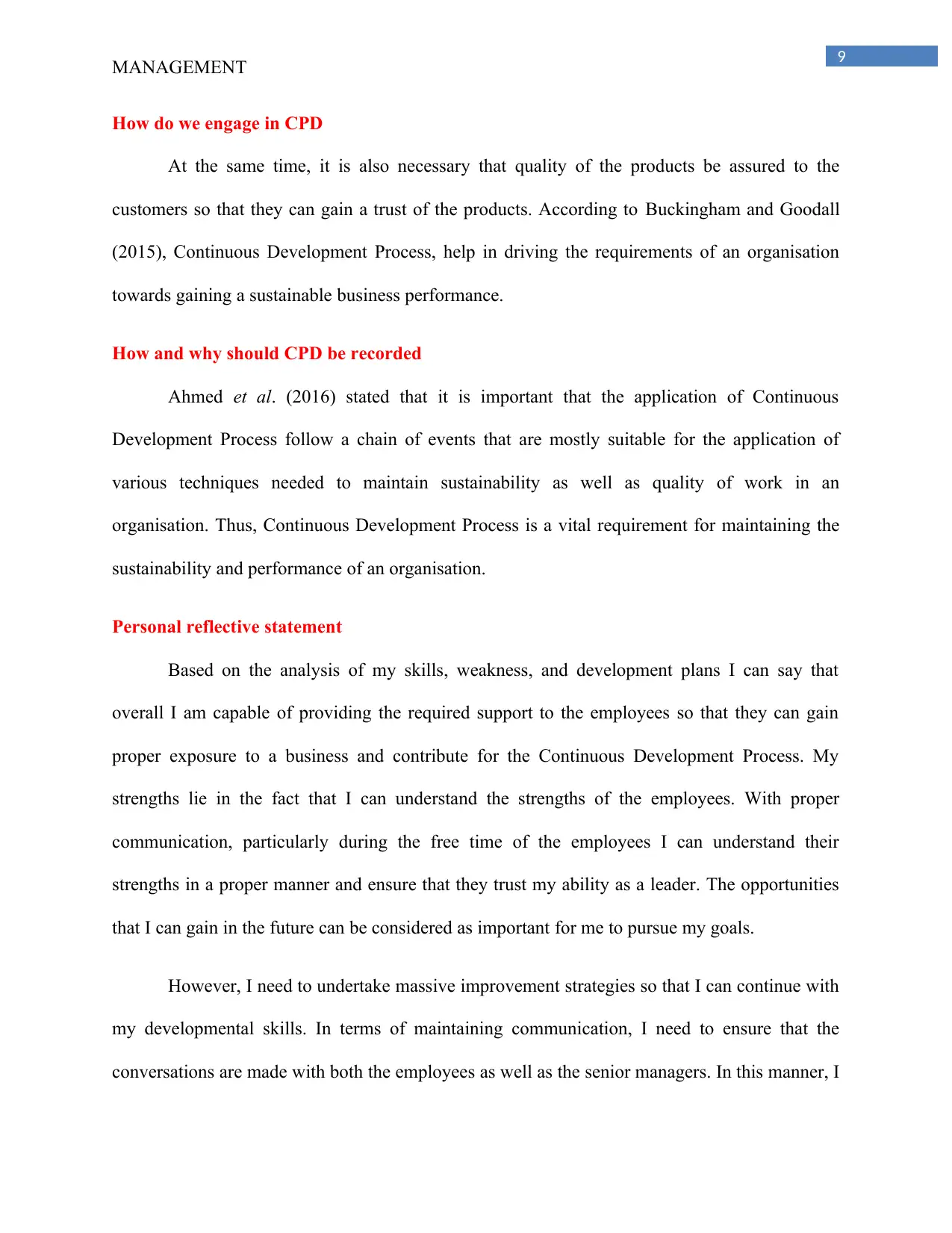
9
MANAGEMENT
How do we engage in CPD
At the same time, it is also necessary that quality of the products be assured to the
customers so that they can gain a trust of the products. According to Buckingham and Goodall
(2015), Continuous Development Process, help in driving the requirements of an organisation
towards gaining a sustainable business performance.
How and why should CPD be recorded
Ahmed et al. (2016) stated that it is important that the application of Continuous
Development Process follow a chain of events that are mostly suitable for the application of
various techniques needed to maintain sustainability as well as quality of work in an
organisation. Thus, Continuous Development Process is a vital requirement for maintaining the
sustainability and performance of an organisation.
Personal reflective statement
Based on the analysis of my skills, weakness, and development plans I can say that
overall I am capable of providing the required support to the employees so that they can gain
proper exposure to a business and contribute for the Continuous Development Process. My
strengths lie in the fact that I can understand the strengths of the employees. With proper
communication, particularly during the free time of the employees I can understand their
strengths in a proper manner and ensure that they trust my ability as a leader. The opportunities
that I can gain in the future can be considered as important for me to pursue my goals.
However, I need to undertake massive improvement strategies so that I can continue with
my developmental skills. In terms of maintaining communication, I need to ensure that the
conversations are made with both the employees as well as the senior managers. In this manner, I
MANAGEMENT
How do we engage in CPD
At the same time, it is also necessary that quality of the products be assured to the
customers so that they can gain a trust of the products. According to Buckingham and Goodall
(2015), Continuous Development Process, help in driving the requirements of an organisation
towards gaining a sustainable business performance.
How and why should CPD be recorded
Ahmed et al. (2016) stated that it is important that the application of Continuous
Development Process follow a chain of events that are mostly suitable for the application of
various techniques needed to maintain sustainability as well as quality of work in an
organisation. Thus, Continuous Development Process is a vital requirement for maintaining the
sustainability and performance of an organisation.
Personal reflective statement
Based on the analysis of my skills, weakness, and development plans I can say that
overall I am capable of providing the required support to the employees so that they can gain
proper exposure to a business and contribute for the Continuous Development Process. My
strengths lie in the fact that I can understand the strengths of the employees. With proper
communication, particularly during the free time of the employees I can understand their
strengths in a proper manner and ensure that they trust my ability as a leader. The opportunities
that I can gain in the future can be considered as important for me to pursue my goals.
However, I need to undertake massive improvement strategies so that I can continue with
my developmental skills. In terms of maintaining communication, I need to ensure that the
conversations are made with both the employees as well as the senior managers. In this manner, I
Paraphrase This Document
Need a fresh take? Get an instant paraphrase of this document with our AI Paraphraser
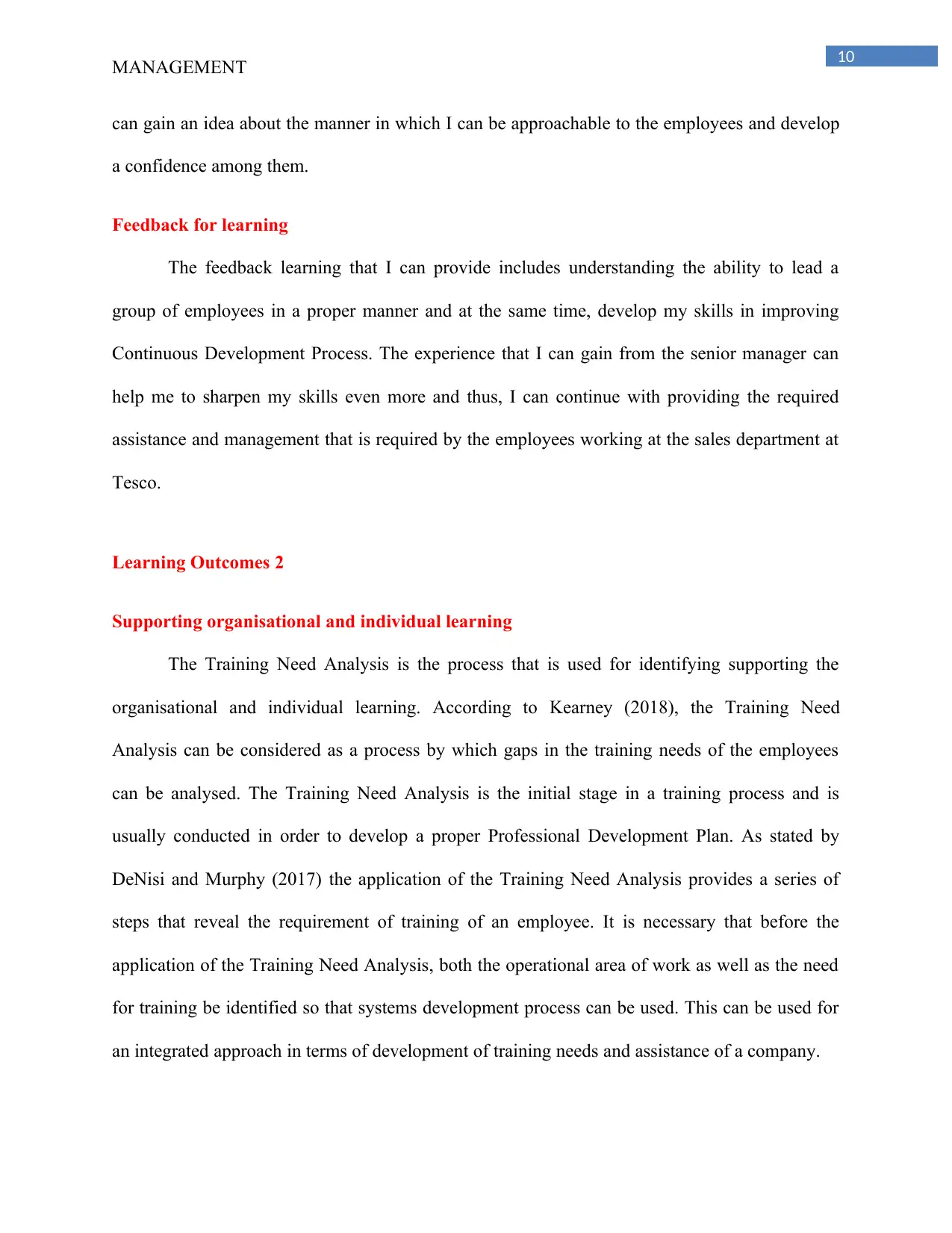
10
MANAGEMENT
can gain an idea about the manner in which I can be approachable to the employees and develop
a confidence among them.
Feedback for learning
The feedback learning that I can provide includes understanding the ability to lead a
group of employees in a proper manner and at the same time, develop my skills in improving
Continuous Development Process. The experience that I can gain from the senior manager can
help me to sharpen my skills even more and thus, I can continue with providing the required
assistance and management that is required by the employees working at the sales department at
Tesco.
Learning Outcomes 2
Supporting organisational and individual learning
The Training Need Analysis is the process that is used for identifying supporting the
organisational and individual learning. According to Kearney (2018), the Training Need
Analysis can be considered as a process by which gaps in the training needs of the employees
can be analysed. The Training Need Analysis is the initial stage in a training process and is
usually conducted in order to develop a proper Professional Development Plan. As stated by
DeNisi and Murphy (2017) the application of the Training Need Analysis provides a series of
steps that reveal the requirement of training of an employee. It is necessary that before the
application of the Training Need Analysis, both the operational area of work as well as the need
for training be identified so that systems development process can be used. This can be used for
an integrated approach in terms of development of training needs and assistance of a company.
MANAGEMENT
can gain an idea about the manner in which I can be approachable to the employees and develop
a confidence among them.
Feedback for learning
The feedback learning that I can provide includes understanding the ability to lead a
group of employees in a proper manner and at the same time, develop my skills in improving
Continuous Development Process. The experience that I can gain from the senior manager can
help me to sharpen my skills even more and thus, I can continue with providing the required
assistance and management that is required by the employees working at the sales department at
Tesco.
Learning Outcomes 2
Supporting organisational and individual learning
The Training Need Analysis is the process that is used for identifying supporting the
organisational and individual learning. According to Kearney (2018), the Training Need
Analysis can be considered as a process by which gaps in the training needs of the employees
can be analysed. The Training Need Analysis is the initial stage in a training process and is
usually conducted in order to develop a proper Professional Development Plan. As stated by
DeNisi and Murphy (2017) the application of the Training Need Analysis provides a series of
steps that reveal the requirement of training of an employee. It is necessary that before the
application of the Training Need Analysis, both the operational area of work as well as the need
for training be identified so that systems development process can be used. This can be used for
an integrated approach in terms of development of training needs and assistance of a company.
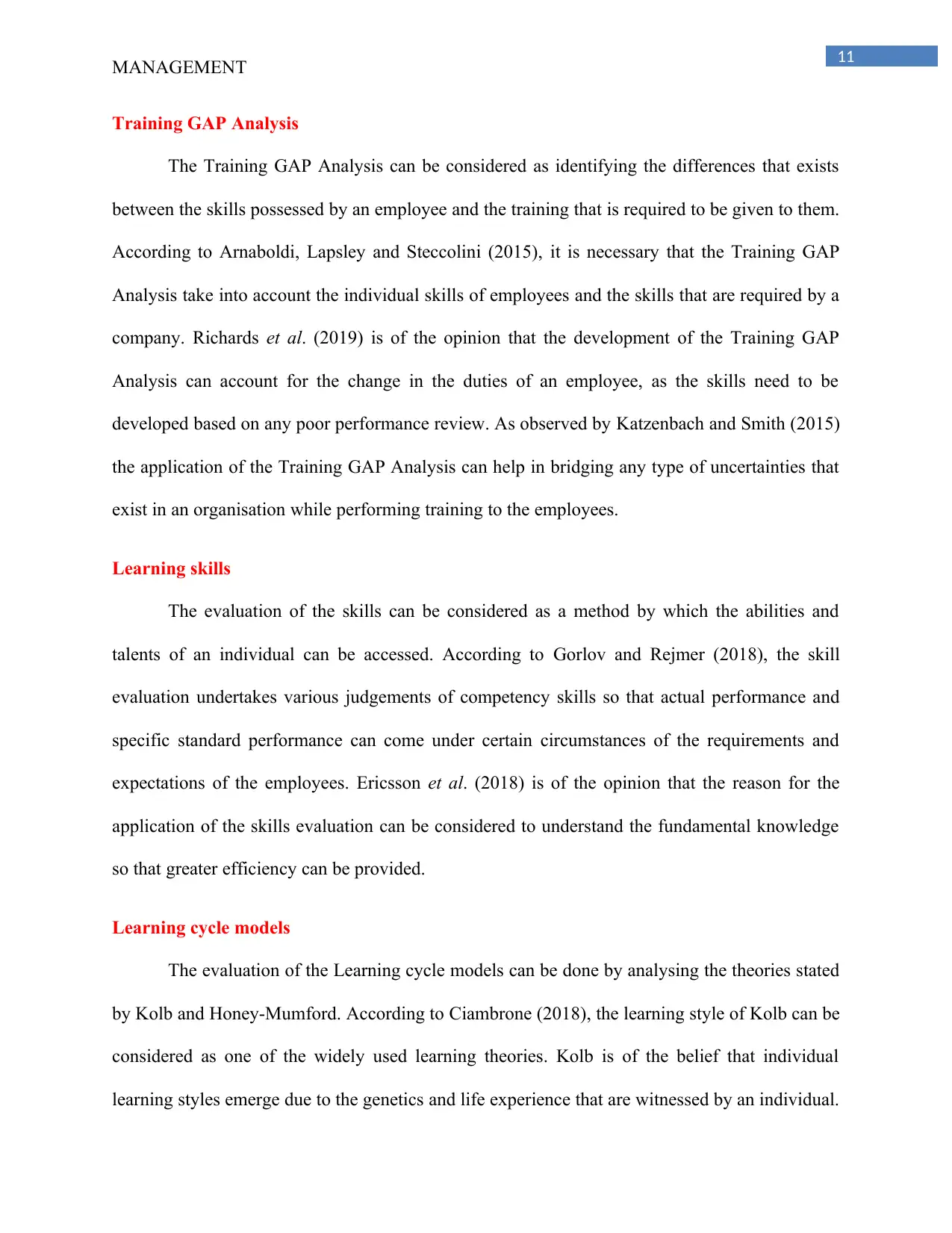
11
MANAGEMENT
Training GAP Analysis
The Training GAP Analysis can be considered as identifying the differences that exists
between the skills possessed by an employee and the training that is required to be given to them.
According to Arnaboldi, Lapsley and Steccolini (2015), it is necessary that the Training GAP
Analysis take into account the individual skills of employees and the skills that are required by a
company. Richards et al. (2019) is of the opinion that the development of the Training GAP
Analysis can account for the change in the duties of an employee, as the skills need to be
developed based on any poor performance review. As observed by Katzenbach and Smith (2015)
the application of the Training GAP Analysis can help in bridging any type of uncertainties that
exist in an organisation while performing training to the employees.
Learning skills
The evaluation of the skills can be considered as a method by which the abilities and
talents of an individual can be accessed. According to Gorlov and Rejmer (2018), the skill
evaluation undertakes various judgements of competency skills so that actual performance and
specific standard performance can come under certain circumstances of the requirements and
expectations of the employees. Ericsson et al. (2018) is of the opinion that the reason for the
application of the skills evaluation can be considered to understand the fundamental knowledge
so that greater efficiency can be provided.
Learning cycle models
The evaluation of the Learning cycle models can be done by analysing the theories stated
by Kolb and Honey-Mumford. According to Ciambrone (2018), the learning style of Kolb can be
considered as one of the widely used learning theories. Kolb is of the belief that individual
learning styles emerge due to the genetics and life experience that are witnessed by an individual.
MANAGEMENT
Training GAP Analysis
The Training GAP Analysis can be considered as identifying the differences that exists
between the skills possessed by an employee and the training that is required to be given to them.
According to Arnaboldi, Lapsley and Steccolini (2015), it is necessary that the Training GAP
Analysis take into account the individual skills of employees and the skills that are required by a
company. Richards et al. (2019) is of the opinion that the development of the Training GAP
Analysis can account for the change in the duties of an employee, as the skills need to be
developed based on any poor performance review. As observed by Katzenbach and Smith (2015)
the application of the Training GAP Analysis can help in bridging any type of uncertainties that
exist in an organisation while performing training to the employees.
Learning skills
The evaluation of the skills can be considered as a method by which the abilities and
talents of an individual can be accessed. According to Gorlov and Rejmer (2018), the skill
evaluation undertakes various judgements of competency skills so that actual performance and
specific standard performance can come under certain circumstances of the requirements and
expectations of the employees. Ericsson et al. (2018) is of the opinion that the reason for the
application of the skills evaluation can be considered to understand the fundamental knowledge
so that greater efficiency can be provided.
Learning cycle models
The evaluation of the Learning cycle models can be done by analysing the theories stated
by Kolb and Honey-Mumford. According to Ciambrone (2018), the learning style of Kolb can be
considered as one of the widely used learning theories. Kolb is of the belief that individual
learning styles emerge due to the genetics and life experience that are witnessed by an individual.
⊘ This is a preview!⊘
Do you want full access?
Subscribe today to unlock all pages.

Trusted by 1+ million students worldwide
1 out of 21
Related Documents
Your All-in-One AI-Powered Toolkit for Academic Success.
+13062052269
info@desklib.com
Available 24*7 on WhatsApp / Email
![[object Object]](/_next/static/media/star-bottom.7253800d.svg)
Unlock your academic potential
Copyright © 2020–2025 A2Z Services. All Rights Reserved. Developed and managed by ZUCOL.



